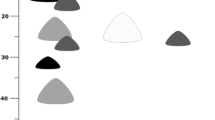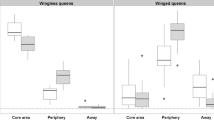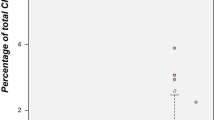Summary
In successive years, two different modes of reproductive behaviour were observed in two nests of the myrmicine antChelaner sp.; emission of winged sexuals followed by claustral colony foundation, and colony fission. A detailed description is given of the first six days of colony fission. After this period 16 incipient daughter colonies had separated from the maternal nest, and the process was still continuing. While it is possible that this species is polymorphic with respect to reproductive behaviour, evidence is presented which suggests an alternative possibility, namely that claustral foundation occurs in this species when environmental conditions are favourable, but that it switches to colony fission under conditions of stress, such as those caused by drought.
Resume
L'observation pendant deux années successives du comportement reproducteur de deux sociétés de la MyrmicineChelaner sp. a permis de mettre en évidence 2 modes de reproduction: émission d'individus ailés aboutissant à une fondation par femelle isolée et bouturage de la société. On présente une description détaillée des six premiers jours qui suivent le bouturage de la société. A l'issue de cette période, 16 colonies filles s'étaient séparées du nid mère, le bouturage se poursuivant encore. Il est donc possible que cette espèce présente un polymorphisme reproducteur: lorsque les conditions de l'environnement sont favorables, il y a fondation indépendante; des conditions moins favorables causées par exemple par la sécheresse entraînent la réalisation des bouturages.
Similar content being viewed by others
References
Brian M.V., 1965. — Social Insect PopulationsAcademic Press, London and New York, 135 p.
Briese D.T., 1982a. — Relationship between the seed-harvesting ants and the plant community in a semi-arid environment. In:Ant-Plant Interactions in Australia (R. Buckley, ed.), Dr. W. Junk, publ., The Hague, 11–24 p.
Briese D.T., 1982b. — Resource partitioning among seed-harvesting ants in semi-arid Australia.Aust. J. Ecol., 7, 299–307.
Briese D.T., Macauley B.J., 1977. — Physical structure of an ant community on semiarid Australia.Aust. J. Ecol., 2, 107–120.
Briese D.T., Macauley B.J., 1980. — Temporal structure of an ant community in semiarid Australia.Aust. J. Ecol., 5, 121–134.
Hölldobler B., Wilson E.O., 1977. — The number of queens: an important trait in ant evolution.Naturwissenschaften, 64, 8–15.
Taylor R.W., 1978. —Nothomyrmecia macrops: a living-fossil ant rediscovered.Science, 201, 979–985.
Wheeler W.M., 1917. — The phylogenetic development of subapterous and apterous castes in the Formicidæ.Proc. Nat. Acad. Sci., 3, 109–117.
Wilson E.O., 1971. — The Insect Societies.Belknap, Cambridge, 528 p.
Author information
Authors and Affiliations
Rights and permissions
About this article
Cite this article
Briese, D.T. Different modes of reproductive behaviour (including a description of colony fission) in a species ofChelaner (Hymenoptera: Formicidae). Ins. Soc 30, 308–316 (1983). https://doi.org/10.1007/BF02223988
Received:
Accepted:
Issue Date:
DOI: https://doi.org/10.1007/BF02223988




